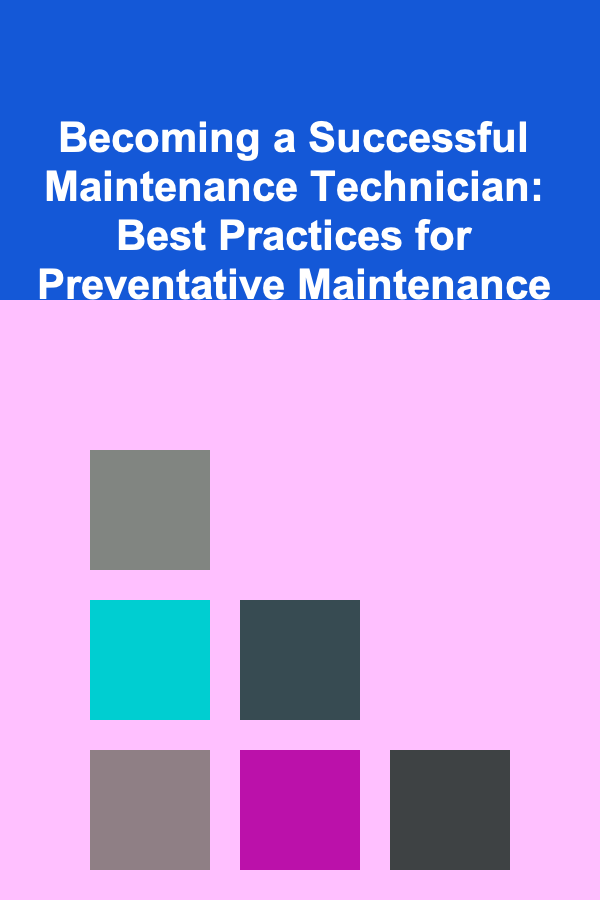
Becoming a Successful Maintenance Technician: Best Practices for Preventative Maintenance
ebook include PDF & Audio bundle (Micro Guide)
$12.99$9.99
Limited Time Offer! Order within the next:

The role of a maintenance technician is vital in ensuring the smooth operation of equipment and systems across various industries, from manufacturing and construction to hospitality and healthcare. A maintenance technician is responsible for both routine and emergency repairs, ensuring that operations are not interrupted by equipment failure. One of the most important responsibilities is conducting preventative maintenance (PM), which can drastically reduce downtime, lower repair costs, and extend the life of machinery. In this guide, we will explore best practices that can help a maintenance technician excel in their role, focusing on preventative maintenance strategies and practical insights.
Understanding Preventative Maintenance
Preventative maintenance refers to the routine, scheduled maintenance performed on equipment and systems to prevent unexpected breakdowns or malfunctions. Unlike reactive maintenance, which occurs only when something goes wrong, preventative maintenance aims to identify and address potential issues before they develop into serious problems.
Preventative maintenance is not just about fixing problems---it's about anticipating them. This proactive approach can significantly reduce unscheduled downtime, improve safety, increase efficiency, and enhance the overall longevity of assets. As a maintenance technician, developing a solid understanding of preventative maintenance techniques is essential to excelling in the role.
Key Practices for Successful Preventative Maintenance
1. Create a Detailed Maintenance Schedule
A successful preventative maintenance program starts with a well-structured schedule. This involves setting clear, periodic intervals for inspections and maintenance tasks based on manufacturer recommendations, equipment usage, and industry standards.
How to Develop a Schedule:
- Manufacturer Guidelines: Always refer to the manufacturer's manual for recommended maintenance intervals. These are often based on the equipment's design and its expected lifespan.
- Equipment Usage: For high-use machinery, you may need to increase the frequency of inspections. For example, machinery in continuous operation may require daily checks, while less frequently used equipment may only need monthly or quarterly maintenance.
- Data-Driven Decisions: Leverage historical data on equipment performance and downtime. This can help you adjust maintenance schedules based on the actual performance of each asset.
Having a clear and actionable maintenance schedule will help ensure that no equipment is overlooked and that routine checks are consistently performed.
2. Develop a Preventative Maintenance Checklist
A well-organized checklist is an essential tool for ensuring that every maintenance task is carried out properly and consistently. It also serves as documentation for compliance and audits.
Key Components of a Checklist:
- Inspection Tasks: Define the specific areas to check, such as oil levels, lubricants, wear and tear, and operational functions.
- Cleaning Requirements: Specify cleaning tasks, such as dusting, washing, or clearing debris from critical components like filters, vents, or fan blades.
- Lubrication: Ensure all moving parts are properly lubricated, as inadequate lubrication can lead to excessive wear.
- Replacement and Adjustments: Regularly check for parts that may need replacing or adjustments to maintain efficiency. This might include belts, seals, gaskets, and sensors.
- Safety Measures: Include safety checks like verifying that safety guards are in place and operational, and confirming that emergency stops and alarms are functioning properly.
A checklist ensures that no step is skipped during routine maintenance, helping to catch issues early before they lead to costly breakdowns.
3. Emphasize Consistency in Record-Keeping
Effective record-keeping is crucial for long-term success in preventative maintenance. By maintaining detailed records of maintenance activities, technicians can identify patterns, anticipate future issues, and make more informed decisions.
Key Records to Maintain:
- Service Logs: Keep detailed records of each maintenance activity, including the date, technician's name, tasks performed, parts replaced, and any observations.
- Equipment History: Track the historical performance of each machine, noting recurring problems, repairs, or replacements.
- Cost Tracking: Maintain a record of maintenance costs to help identify equipment that is becoming costly to maintain and may need replacing or upgrading.
- Parts Inventory: Regularly update inventory records for parts and materials used in preventative maintenance tasks to ensure timely availability.
Proper documentation not only helps improve the efficiency of future maintenance but also provides valuable insight during audits, troubleshooting, and decision-making processes.
4. Regularly Inspect Critical Components
Certain components of equipment or machinery are more critical than others and require more frequent inspections. These parts, if neglected, can cause serious operational issues. Focus on these areas during your preventative maintenance routines:
- Motors and Bearings: These are often subject to wear and tear. Regularly check for overheating, unusual noises, or vibration.
- Hydraulic Systems: Regularly inspect fluid levels and check for leaks or contamination.
- Electrical Systems: Look for signs of wear on cables, connectors, and switches. Conduct checks for overheating or tripped circuit breakers.
- Pumps and Valves: Ensure that seals are intact, and that the systems are operating within the correct pressure range.
By focusing on these high-priority components, you can detect signs of damage early and prevent catastrophic failure.
5. Embrace Technology and Automation
Advancements in technology can significantly improve the effectiveness and efficiency of preventative maintenance. Automation tools and software solutions can help technicians track and schedule maintenance tasks, monitor equipment performance, and even predict failures based on real-time data.
Tools to Consider:
- Computerized Maintenance Management Systems (CMMS): A CMMS is a software platform that helps track equipment health, manage work orders, schedule maintenance, and maintain records.
- Condition Monitoring: Tools that monitor the real-time condition of machinery (e.g., vibration sensors, temperature sensors) can provide early warning signs of issues, allowing for more targeted maintenance efforts.
- Predictive Maintenance (PdM): Use data analytics to predict when a machine is likely to fail based on patterns and trends, so maintenance can be performed just before a failure occurs.
By embracing technology, you can move from reactive maintenance to a more proactive and data-driven approach, helping you stay ahead of potential issues.
6. Proper Training and Skill Development
To be an effective maintenance technician, it is essential to keep up with the latest tools, techniques, and technologies in the industry. Continuous learning ensures that you can handle both traditional and modern equipment and respond to new challenges effectively.
Areas to Focus On:
- Technical Knowledge: Stay updated on the latest machinery, tools, and safety protocols. Ensure that you understand the operation and maintenance requirements of each piece of equipment.
- Troubleshooting: Develop strong diagnostic skills. Being able to quickly identify the root cause of an issue is a valuable skill in both preventative and reactive maintenance.
- Safety Training: Regularly update your knowledge on safety standards and protocols. Safety should always be a priority, both for yourself and others working around the equipment.
Regular training helps ensure that you can carry out all tasks efficiently and safely, while also preparing you to handle unexpected challenges.
7. Promote a Culture of Preventative Maintenance
As a maintenance technician, you are an integral part of fostering a culture of preventative maintenance within your organization. Encourage your colleagues and management to recognize the importance of regular maintenance and its long-term benefits.
How to Promote a Preventative Maintenance Culture:
- Education and Awareness: Educate team members about the value of preventative maintenance. Help them understand that investing time in PM can save costs in the long run.
- Collaboration with Other Teams: Work closely with operators, engineers, and managers to ensure that everyone understands the importance of maintaining equipment. Collaborative efforts often result in smoother operations and quicker identification of issues.
- Incorporate Feedback: Listen to feedback from operators about the performance of equipment. They often notice early signs of wear or inefficiency that may not be apparent during scheduled maintenance.
By promoting a culture of preventative maintenance, you can foster an environment where all employees understand the role they play in keeping operations running smoothly.
Conclusion
Becoming a successful maintenance technician involves mastering the art of preventative maintenance. By implementing a structured approach, developing thorough checklists, leveraging technology, and maintaining a strong culture of maintenance, you can help ensure that equipment remains in optimal condition. The goal is not just to fix problems but to prevent them before they disrupt operations, saving time and money while improving efficiency.
With consistent attention to detail, ongoing education, and proactive strategies, maintenance technicians can thrive in their roles, ensuring the longevity and performance of critical assets across industries.
Reading More From Our Other Websites
- [Home Maintenance 101] How to Prevent Water Damage With Regular Home Inspections
- [Home Maintenance 101] How to Inspect and Maintain Your Home's Electrical Panel
- [Organization Tip 101] How to Organize BBQ Utensils for Outdoor Cooking
- [Organization Tip 101] Top Kitchen and Bathroom Remodeling Tips for 2025
- [Personal Finance Management 101] How to Avoid Impulse Buying and Save More Money
- [Home Holiday Decoration 101] Best Ideas for Holiday Home Decor That Is Both Festive and Elegant
- [Organization Tip 101] How to Organize Your Knitting and Crochet Supplies
- [Home Renovating 101] How to Make Your Home More Energy-Efficient During Renovation
- [Personal Care Tips 101] How to Incorporate Dry Shampoo Into Your Post-Gym Hair Routine
- [Home Storage Solution 101] How to Maximize Vertical Space with Wall-Mounted Storage

How to Create a Customer Service Script for Your Team
Read More
How to Create a Home Security Plan for Families with Young Children
Read More
How to Create a Kid-Friendly Reading Corner
Read More
How to DIY Your Home Decor with Inexpensive Materials
Read More
Exploring the Myths of the Ancient Near East
Read More
10 Tips for Dealing with Inconsistent Child Support Payments
Read MoreOther Products

How to Create a Customer Service Script for Your Team
Read More
How to Create a Home Security Plan for Families with Young Children
Read More
How to Create a Kid-Friendly Reading Corner
Read More
How to DIY Your Home Decor with Inexpensive Materials
Read More
Exploring the Myths of the Ancient Near East
Read More